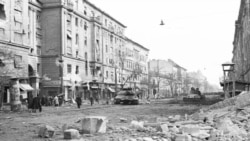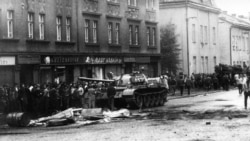On October 27, Hungarian Prime Minister Viktor Orban gave a speech commemorating a recently unveiled monument to former U.S. President George Herbert Walker Bush on Budapest’s Liberty Square. Bush, who died in 2018, visited Hungary as U.S. president in 1989, when that country’s communist regime, like others throughout the Soviet-aligned Eastern Bloc, was on the verge of collapse.
Orban recalled Bush’s visit, noting that Hungarians implored the U.S. president to “save us from Yalta,” referring to the World War II-era agreement by which the Western allies agreed to hand over control of Central and Eastern Europe to the Soviet Union as its armies pushed the Germans back toward Berlin.
“We Hungarians do not want to make a better deal with the Soviet Union, but to break away from it,” Orban said, explaining that Bush understood the country’s mood in 1989.
Orban noted the new statue’s location in the square and close proximity to both a memorial to victims of the Nazi occupation and a Soviet war memorial, which he referred to as a “monument of the Soviet occupation.” Orban said this sent a “clear message” that Hungarians could choose either occupiers or freedom.
But Orban’s portrayal of the Soviet war memorial as a “monument of the Soviet occupation” provoked a harsh reply from Russian Foreign Ministry spokesperson Maria Zakharova on October 29.
“On October 27, Prime Minister Viktor Orban said in his speech on Szabadsag (Liberty) Square in Budapest that the monument commemorating the 80,000 Red Army soldiers who perished liberating the city from Nazi invaders was ‘a memorial to the victims of the Soviet occupation,’” Zakharova said in the statement.
Zakharova said Hungary was a member of the German-aligned Axis powers during most of WWII and fought alongside the German military in several campaigns, including the invasion and occupation of the Soviet Union in the summer of 1941. She said Hungarian occupation troops were implicated in war crimes on Soviet soil.
“The Red Army liberated European nations from the Nazi plague and brought peace and freedom to them,” Zakharova’s statement concluded. “But today some countries are trying to distort this fact, withhold the truth about the key role played by the Soviet Union in Victory over Nazism, hush up some capitals’ historical responsibility for war crimes and whitewash the governments of Nazi accomplices.”
While Zakharova’s assertions about Hungary’s role in the war are mostly true, her claim that the Red Army brought Hungary and other European nations “peace and freedom” is misleading.
Even before WWII ended, pro-Moscow communist governments were set up in Central and Eastern European countries as the Red Army pushed the Nazi forces back into Germany. After the Red Army captured Berlin, Germany and its capital were divided into occupation zones administered by the USSR and its Western allies – Britain, the United States and France.
While the European countries liberated by the Western allies returned to democratic rule, those occupied by Soviet forces saw the establishment of dictatorships run by Soviet-aligned communist parties which ruled by means of secret police, censorship and repression.
As for “peace,” East German workers rose up against their Soviet-installed regime in 1953. To suppress the protests, Soviet occupation forces declared martial law and put tanks in the streets.
Hungary faced even more severe repression in 1956, when Soviet Red Army forces suppressed an uprising that turned violent. Local citizen militias battled Soviet mechanized units in Budapest. Some 2,500-3,000 Hungarians were killed and as many as 200,000 fled the country into neutral Austria.
Although not nearly as bloody, Soviet tanks and troops again clashed with local protesters in Czechoslovakia during its 1968 “Prague Spring.”
In 1991, Soviet troops stormed the state TV and radio station in the Lithuanian capital of Vilnius to quell a bid for independence from the Soviet Union. Thirteen people were killed and dozens wounded in the violence.
Lithuania had been an independent country in between the world wars, but under a secret portion of the Molotov-Ribbentrop Pact, the non-aggression agreement the Soviet Union and Nazi Germany signed in 1939, the three Baltic states – Lithuania, Latvia and Estonia – were annexed to the Soviet Union. They were subsequently occupied by Nazi forces, but after they were recaptured by the Red Army in 1944-45, they were reincorporated into the Soviet Union. All three Baltic states experienced mass deportations and repression under Soviet rule.
In her statement, Zakharova referred to alleged attempts by some countries today to “whitewash the governments of Nazi accomplices.” This also is misleading.
Russia itself has been accused of whitewashing the Soviet Union’s agreement to carve up Central and Eastern Europe into spheres of influence. In recent years Russian officials, including President Vladimir Putin, have tried to underplay the significance of the Molotov-Ribbentrop Pact in contributing to Germany’s September 1939 invasion of Poland, which is generally regarded as the start of WWII.







